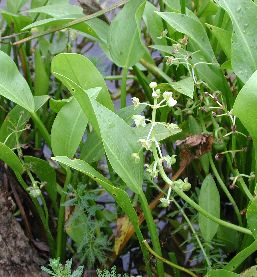
Sagittaria spp.
Non-Herbicide Management Options
1. Physical Management Options
Arrowhead can be removed by raking or seining it from the pond, but will re-establish from any remaining roots and seeds.
2. Biological Management Options
At this time, there are no known biological management options for arrowhead.
Herbicide Control Options
Always read the product label for directions and precautions, as the label is the law. Click on the name of the product to see the label. Read the label for specific water use restrictions.
Active ingredients that have been successful in treating this plant include:
- Bispyribac (Rated: Excellent)
- Flumioxazin (Rated: Good)
- Glyphosate (Rated: Excellent)
- Imazamox (Rated: Excellent)
- Imazapyr (Rated: Excellent)
- 2,4-D (Rated: Excellent)
These ratings are based upon the U.S. Army Corps of Engineers aquatic herbicide trials.
1) Bispyribac
Bispyribac-sodium comes in water soluble powder form in packets. Each packet should be mixed with water first and then sprayed or injected. It is a selective, systemic herbicide. Systemic Herbicides are absorbed and move within the plant to the site of action. Systemic herbicides tend to act more slowly than contact herbicides. A surfactant (substance that can reduce the surface tension) will be needed if herbicide is applied to foliage of floating or emergent plants.
Common trade and product names include but are not limited to:
2) Flumioxazin
Flumioxazin is a water dispensable granule that is to be sprayed or injected after mixing. It is a broad spectrum, contact herbicide. Contact herbicides act quickly. Flumioxazin should be applied to actively growing plants and a surfactant (a substance that reduces water tension) will be needed if the herbicide is applied to foliage of floating or emergent plants. Water pH needs to be below 8.5 or flumioxazin will rapidly degrade and lose effectiveness.
Common trade and product names include but are not limited to:
3) Glyphosate
Liquid glyphosate formulations have been effective on arrowhead above the water line, but ineffective on plants in the water. They are broad spectrum, systemic herbicides. Systemic herbicides are absorbed and move within the plant to the site of action. Systemic herbicides tend to act more slowly than contact herbicides. An aquatically registered surfactant (see the label) will have to be added to the glyphosate solution for good results.
Common trade or product names include but are not limited to:
4) Imazamox
Imazamox is a broad spectrum, systemic herbicide. Systemic herbicides are absorbed and move within the plant to the site of action. Systemic herbicides tend to act more slowly than contact herbicides. An aquatically registered surfactant (see the label) is needed for application.
Common Trade of product names include but are not limited to:
5) Imazapyr
The active ingredient, imazapyr, inhibits the plant enzyme AHAS (acetohydroxyaced synthase). Habitat is a systemic herbicide that is effective on post-emergent floating and emergent aquatic vegetation. Imazapyr is effective at low-volume rates and does not contain heavy metals, organochlorides or phosphates, making it safe to humans and livestock. Habitat requires the use of a spray adjutant when applying on post-emergent vegetation.
Common trade or product names include but are not limited to:
6) 2,4-D
2,4-D compounds are systemic herbicides. Systemic herbicides are absorbed and move within the plant to the site of action. Systemic herbicides tend to act more slowly than contact herbicides.
Common trade or product names include but are not limited to:
Precautions
One danger with any chemical control method is the chance of an oxygen depletion after the treatment caused by the decomposition of the dead plant material. Oxygen depletion can kill fish in the pond. If the pond is heavily infested with weeds, it may be possible (depending on the herbicide chosen) to treat the pond in sections and let each section decompose for about two weeks before treating another section. Aeration, particularly at night, for several days after treatment may help control the oxygen depletion.
One common problem in using aquatic herbicides is determining area and/or volume of the pond or area to be treated. To assist you with these determinations see SRAC #103 Calculating Area and Volume of Ponds and Tanks.
Many aquatically registered herbicides have water use restrictions (See General Water Use Restrictions).
To see the labels for these products click on the name. Always read and follow all label directions. Check label for specific water use restrictions.
Cultivation Options
Arrowheads spread rapidly by seeds and extensive rhizomes.
Questions?
If you need assistance, contact the Ag & Natural Resources agent in your county or hire a professional.